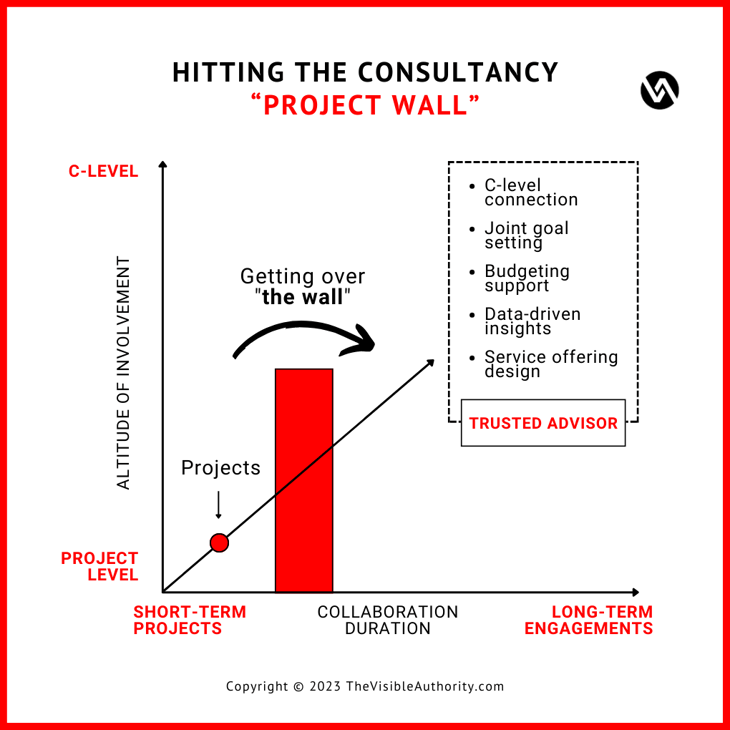
Getting Over 'The Project Wall' To Grow A Consultancy Firm

This article was last updated on 18 September 2023
I often conduct workshops with mid-sized consulting firms as a follow up to a positioning audit I conduct for them. One of the discussions that comes up during such workshops rather frequently is how boutique consultancies and mid-sized firms can move away from project-level work to C-level involvement with their clients. In this post, I summarize the main points of such discussions and the strategies I've shared with consultancies over the years.
But first, I'll provide a quick review of the altitude of involvement concepts in consulting business models.
Project- vs C-level work in consulting
Project-level work is low-altitude. It centers primarily around day-to-day execution and/or implementation work, which has relatively low impact on the clients' true pains.
C-level work, on the other hand, is high-altitude. It's all about high-level strategic and/or diagnostic advisory. This type of work tends to have a relatively big impact on the clients' true pains. High-performing consultancies tend to fall in the latter category. They position their offering as "transformative", which means the work requires deep expertise and they are able to charge premiums.
Switching to the C-level ‘client transformation’ consulting approach is THE #1 pillar of success in consulting – the type of success where consultancies regain control of their time, when consultancy owners comfortably and organically grow their business and pick which projects their teams work on (and say NO to any project outside of the consultancy's focus zone), and where marketing is inbound.
Recommended reading: Utilization or Demotivation? The Hidden Cost Consultancies Pay When Chasing Billable Hours
Hitting and overcoming the 'Project Wall'
Unfortunately, too many consultancies never get over ‘the project wall’. They wish to become strategic advisors but get stuck in lower-value project work (or even ‘body shopping’).
Here is a visual representation of the growth trajectory.

Typical characteristics of consulting work in front and behind the wall
Characteristics of the project work ‘in front of the wall’
- Frantic pace and high unbillable time: Consultancies tend to engage in a never-ending cycle of writing proposals, pitching, and onboarding new clients – all of which leads to significant time that cannot be billed, causing inefficiency and stress.
- Low revenue/FTE: A lack of high-value projects results in diminished revenue generation per employee or a sub-standard ‘cost-to-revenue’ ratio.
- Growth ceiling: These consultancies growth pattern gets stagnant. They are unable to break through to new levels of expansion and success.
- High cost of sales (COS) to acquire new clients: The constant need to win new clients leads to significant sales costs, draining resources that could be allocated elsewhere.
- Capacity issues: Over-extension causes internal capacity challenges, disrupting workflow and potentially affecting the quality of deliverables.
- Financial instability and uncertainty: Fluctuating revenue streams and the ever-present need to secure new projects create an environment of uncertainty and stress in consultancies in front of the wall.
- Employee burnout risk: The relentless pace often leads to employee fatigue and burnout, affecting performance and retention.
- Lack of long-term client relationships: Since such consulting firms tend to focus on one-off projects, they miss opportunities for deeper client engagement and recurring revenue.
- Reactive instead of proactive approach: The continuous scramble for new projects promotes a reactive culture, missing the opportunity to position a consultancy for future success strategically.
Did I paint a vivid picture of 'hitting the project wall' in consulting? Understanding these signs is crucial for transforming towards a more strategic, stable, and growth-oriented consulting approach.
Relying on one-time projects is like running a race with ever-changing finish lines. Each completed project leads to another wall, another beginning, with no momentum or cumulative growth.
My friend Simon Collard would say: in a state of ‘existential fragility’.
Recommended reading: The Negative Impact of Obsessive Revenue Focus in Consulting
Characteristics of consulting work ‘behind the wall’
- Minimal unbillable time: The proposals process tends to be highly standardized and optimized due to the very narrow range of services offered. In fact, almost every process and system in such high-performing consultancies behind the wall is optimized for maximum efficiency. They are able to do that due to repetition in types of projects they deliver and continuous commitment to deepen the expertise.
- High revenue/FTE due to value-based premium pricing: These consultancies do not sell availability. They sell the transformational value they deliver to clients. As a result, their profit margins are high and their revenue growth is not directly tied to headcount growth.
- Low cost of sales (COS) to acquire new clients: Because of the strong positioning of such consultancies as exceptional experts in a narrow field and their reputational footprint backed by social proof, such firms spend very little – if anything – on marketing and business development.
- Strong capacity planning: Resources and team members can be allocated to projects with high accuracy. With forecast planning usually quite meticulous and precise in such firms, overstretching or underutilizing staff and resources is an exception rather than the rule.
- Financial stability: High-performing consultancies behind the wall secure financial stability through recurring revenue sources – be it monthly retainers, subscription-based models, or long-term client projects. New business is used for business growth, to diminish the risk of financial dependency on a few big clients, and to keep the pricing at healthy levels.
- Solid employee retention rates: These consulting firms rarely face high employee turnover problems. Revenue is predictable. There is no pressure on individual consultants to sell. Consulting leaders at such firms tend to place a lot of value into continuous learning, enabling consultants to deepen their expertise. There is prestige associated with working at such high-performing consultancies due to their strong reputational footprint.
- Proactive and strategic approach to consultancy management: Financial stability and the ability to say no to incoming requests gives consulting leaders the time and space to think of business growth and management strategically instead of making reactive decisions. They have the luxury to set the parameters for where they want to see their business in 2/5/10 years and make decisions that can deliver success over the long term as opposed to chasing short-term wins.
Recommended reading: Why Vertical Service Integration Is the Future of Growth for Boutique Consultancies
In his book, ‘Crossing The Chasm’, Geoffrey Moore talks about 'the chasm' – a concept similar to what I refer as a 'project wall'. His definition of ‘the chasm’: reaching a plateau and struggling to move to the next level.
When I talk to the consulting firms struggling with ‘the wall’ (or ‘the chasm’), most of them have the ambition to get over the wall but don’t know how to start that journey.
I’ve been there, got the t-shirt.
How to get over the wall
Every boutique consultancy hits the project wall on the road to building a more mature firm. I’ve been there myself, and sometimes it was very frustrating.
But 'getting over the wall' became my obsession. I planned to become the TRUSTED ADVISOR by doing these 5 things:
- Strategic service offering design: This involves developing a comprehensive service portfolio that goes beyond just completing a project. It's about creating a continuum of services that align with the evolving needs of clients. This approach not only ensures client retention but also opens doors for upselling and cross-selling opportunities.
- Building long-term executive-level relationships: The focus here is on cultivating deep and meaningful relationships with high-level decision-makers. By engaging with executives, consultants can gain insights into the strategic direction of the client's company, enabling them to tailor their services more effectively and become indispensable partners.
- Goal setting assistance for clients: Consultants should actively participate in their clients' goal-setting processes. This isn't just about understanding their short, medium, and long-term objectives but also about aligning your consultancy's offerings with these goals. This alignment ensures that the consultancy is seen as a critical player in achieving these objectives.
- Support in building budgets & teams: Here, the consultancy's role expands into advising on the allocation of resources and the structuring of teams. This advice should be grounded in the consultancy's domain expertise, ensuring that the client is equipped with the right resources and human capital to achieve their goals.
- Advising on data collection for decision support: In today's data-driven world, guiding clients on how to collect and analyze data for insightful decision-making is crucial. This involves not just the technical aspects of data collection but also understanding how to interpret this data to provide strategic insights and support decision-making processes.
My advice pivots around transforming a consultancy from a transactional service provider into a strategic partner. This shift involves deeply integrating the client's business strategy, thoroughly understanding their long-term goals, and providing tailored data-driven advice. By doing so, consultancies can break through the project wall, moving towards a more sustainable and growth-oriented business model.
A few factors to watch out for
Lack of executive advisory expertise in consulting teams
In my observations of the consultancy landscape, firms that have primarily focused on short-term projects often find themselves lacking in the skills necessary for high-level executive engagement.
It’s a significant challenge to reorient a project-centric team to become adept at executive advising. For leaders of boutique consultancies, the key is not to abandon project work but to enhance your team's capabilities by hiring consultants with 'upstream-savvy' skills.
These professionals should excel in understanding and aligning with client executives' strategic goals. Integrating such talent allows your consultancy to maintain its strength in project delivery while simultaneously elevating its role to a strategic partner. This dual approach ensures the continuation of successful project work alongside the development of deeper, more strategic relationships with clients, providing a comprehensive service that addresses both immediate project needs and long-term executive objectives.
When I shared my article on LinkedIn, I got a few great comments from Consulting Professor Joe O’Mahoney.
- Comment 1: In an attempt to ‘jump over the wall’, consultancies should be careful to transform a project offering into a strategic offering. This is (a) too risky and (b) turns their back on 'bread and butter' revenue. They should attempt to do both to leverage strategic relationships to deliver the projects more widely.
- Comment 2: Moving ‘upstream’ as a consultancy is really, really difficult. Prof. O’Mahoney: “I don't think I've met a CEO who hasn't said 'we trying to move our relationships upstream to the CXO suite. Everyone wants to do it but not everyone has the capability, offering, or relationships to make this happen. The C-suite is the most contested area for consultancies”.
Final advice
Hitting the project wall is not a dead-end.
It’s not easy to move into C-level type of work for consultancies that have been doing project work in an organization for a long time. And going for premium pricing after years of lower-level project pricing could cause a few stupefied client faces.
My advice will always be to first test and develop ‘crossing the wall’ activities with new clients.
Interested in receiving all my learnings to build a better consultancy?
Subscribe to my newsletter.

Luk’s extensive career in the consulting business, which spans more than 20 years, has seen him undertake a variety of influential positions. He served as the European CHRO for Nielsen Consulting (5,000 consultants in the EU), founded iNostix in 2008—a mid-sized analytics consultancy—and led the charge in tripling revenue post-acquisition of iNostix by Deloitte (in 2016) as a leader within the Deloitte analytics practice. His expertise in consultancy performance improvement is underlined by his former role on Nielsen's acquisition evaluation committee. After fulfilling a three-year earn-out period at Deloitte, Luk harnessed his vast experience in consultancy performance improvement and founded TVA in 2019. His advisory firm is dedicated to guiding consulting firms on their path to becoming high-performing firms, drawing from his deep well of consulting industry expertise and financial acumen.

